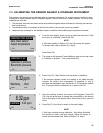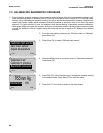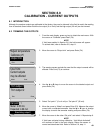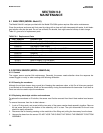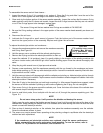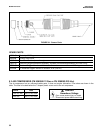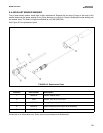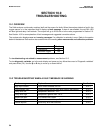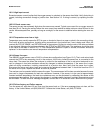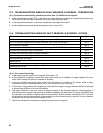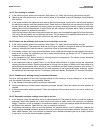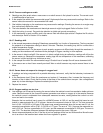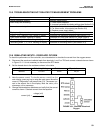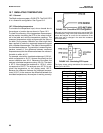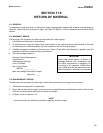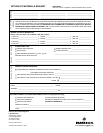
MODEL DO-03/04 SECTION 10.0
TROUBLESHOOTING
10.2.1 High input current
Excessive sensor current implies that the oxygen sensor is miswired or the sensor has failed. Verify that wiring is
correct, including connections through a junction box. See Section 3.3. If wiring is correct, try replacing the sen-
sor.
105.2.2 Check sensor zero
The sensor current was extremely high when the sensor was zeroed. Typical zero current for an oxygen sensor is
less than 50 nA. Zeroing the sensor before the zero current has reached a stable minimum value will lead to low
results. Allow adequate time, possibly as long as overnight, for the sensor to stabilize before starting the zero rou-
tine.
10.2.3 Temperature error low or high
Temperature error usually means the RTD is open or shorted or there is an open or short in the connecting wiring.
First, verify all wiring connections, including wiring connections in the junction box if one is being used. Next, dis-
connect the RTD IN, SENSE, and RETURN leads at the analyzer. Be sure to note the color of the wire and where
it was attached. Measure the resistance between the RTD IN and RETURN leads. The resistance should be close
to the value in the table in Section 10.7.2. If the temperature element is open or shorted, the sensor should be
replaced. In the meantime use manual temperature compensation.
10.2.4 Sense line open
The 499ADO oxygen sensor uses a Pt100 in a three-wire configuration (see Figure 10-2). The in and return leads
connect the RTD to the measuring circuit in the analyzer. A third wire, called the sense line, is connected to the
return lead. The sense line allows the analyzer to correct for the resistance of the in and return leads and to cor-
rect for changes in lead wire resistance caused by changes in ambient temperature. If the sense line is open,
check all wiring connections, including connections at a junction box. Next, verify that the sense line is open.
Disconnect the sense and return leads and measure the resistance between them. It should be less than 5Ω. If
the sense line is open, replace the sensor as soon as possible.
The analyzer can be operated with the sense line open. The measurement will be less accurate because the ana-
lyzer can no longer compensate for lead wire resistance. However, if the sensor is to be used at approximately
constant ambient temperature, the lead wire resistance error can be eliminated by calibrating the sensor at the
measurement temperature. Errors caused by changes in resistance with changes in ambient temperature cannot
be eliminated. To make the error message disappear, connect the RTD sense and return terminal with a jumper.
10.2.5 Failure factory and Failure eeprom
Turn the power off, wait about 30 sec, then turn the power back on. If the error message does not clear, call the
factory. In the United States, call (800) 854-8257. Outside the United States, call (949) 757-8500.
55



